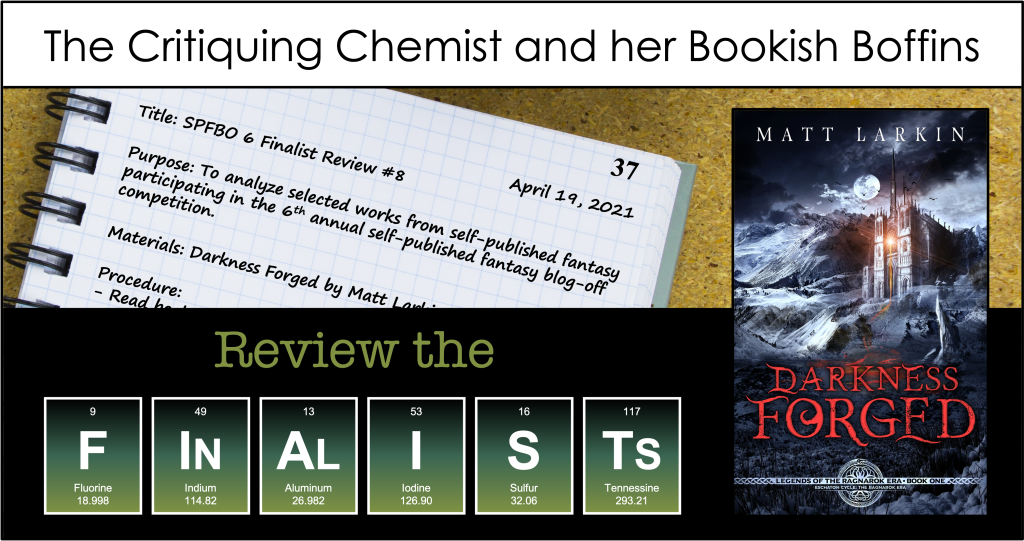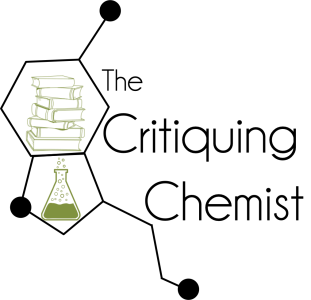
Rate: 7/10
Medium: ebook (224 pages in print)
Overview (No Spoilers):
Sarah’s Thoughts:
Darkness Forged cannot be described as a feel good or happy read but Larkin tells a story that will keep the reader glued at every twist and turn. Relatively short, Darkness Forged follows three brothers in a desperate search to find their missing wives. The story is obviously more complex than my aforementioned description, but I would hate to reveal too much of this fascinating adventure. Each chapter builds the tension through a series of flashbacks, interspersed between how the brothers are each faring in their separate quests. The flashbacks mainly focus upon the middle brother, Volund, who was trained by the dvergar as a smith. The horrors he endures during his time in the mountain were terrible to read, let alone imagine, though crucial for his character’s development, especially in the context of the final scenes.
Each of the brothers has a distinct personality with Agilaz easily being my favorite. Despite their journeys pulling the brothers in opposite directions, all of them encounter their own trials, though seeking out these dangers went hand in hand with the mission. This recipe serves to keep the reader’s attention fixated, especially with each subsequent situation proving to be even more dire than the last.
Larkin has created an intriguing literary world that intertwines characters from Norse mythology with mere mortals. While I’m passingly familiar with Norse mythology characters and terms, I did find I had to look up several names to fully grasp the meaning intended.
While some of the material was dark indeed (hence the title of the book), the general flow was smooth, easily allowing the reader to get lost within the story. Overall, Darkness Forged was a quick read that proves to be a unique twist on a missing person’s search that takes three brothers into unknown lands and a myriad of dangers. Sarah’s Rating: 7/10
Jennie’s Thoughts:
As a master smith, Volund knows what it means to push something to the edge of its breaking point, a method typically used to make one stronger. He learned the process from the best: the dvergars of Nidavellir. But as an apprentice in their subterranean forges, the dvergar may have fostered more than just his smithing skills, as the shadows seem to have taken an interest in Volund as well. After emerging from the depths of Nidavellir, all he wants is to settle into a quiet life in the wilds with his brothers and their partners. This is especially true since Volund’s wife has a way of driving out the darkness that plagues him. They all live blissfully together for nine years, until one day, the three brothers return home from a hunting trip to discover that their wives have gone missing. With nothing but their wedding rings and hope to guide them, they venture off in separate directions to look for their wives, drawn by invisible leads. Not only does this put each of them in the middle of others’ wars, but the mist enshrouding Midgard is an ever-present threat that, if left unchecked, will surely drive them mad…
Darkness Forged was published in August 2017 and is the first book from the Legends of the Ragnarok Era series by Matt Larkin. As is perhaps evident from the series title, Larkin has centered this work on characters from Norse mythology. In actuality, this story is a retelling, with the inspiration for the majority of it coming from the Poetic Edda and the Thidrekssaga. I haven’t read either of these texts, but from what I gather, this version accurately follows the original folklore (aside from Slagfid’s storyline which is from the author’s imagination). In a nod to its roots, this novel incorporates Old Norse terms throughout. As a result, I often looked up words to fully grasp what was going on, but context clues were more prevalent the farther I got into the book.
After getting used to the writing style, I found this to be a quick, engrossing read. Falling under the umbrella of grimdark fantasy, Darkness Forged does not shy away from heavy topics, such as mutilation, rape, slavery, and torture. Really, none of the brothers have it easy as each faces their own set of escalating challenges while searching for their wives. As their stories diverge, Larkin strategically shifts the point-of-view between them to maintain tension. However, I would’ve liked for there to be more overlap across the storylines to feel more cohesive overall (even though that has the potential to change the trajectory of the myth since this is a retelling). Alternatively, some of the disjointedness could stem from the novel focusing predominantly on Volund’s narrative when all three have the same mission and each encounters obstacles.
With Volund at the forefront, it makes sense that he undergoes the most character development (and goodness, is he transformed by the end!). I especially enjoyed how Larkin mixes past and present perspectives to explain where Volund’s head is at and how things came to be. While the other brothers don’t obtain as much overall depth, I’m glad that all of the main characters evolve beyond the first impressions I had of them: Slagfid isn’t as sleazy as I first thought, Agilaz isn’t always stoic, and Volund is more than the family’s peacekeeper. As for the world at large, Midgard is home to both humans and otherworldly beings, many of which the reader has yet to meet. I’d be interested in seeing how the groundwork from this tale fits within Larkin’s other works across the three(!) series he’s written on Norse mythology. Jennie’s Rating: 7/10
The Critiquing Chemist and her Bookish Boffins Average Rating: 7/10
Additional Insight (Spoilers Abound):
- It was only after finishing the book that I realized that the symbols for the chapter headers match which brother the chapter is about. From my limited sleuthing skills, they look like the triple horn of Odin, a symbol of protection, and the triquetra symbol. I’m sure that I’m missing the deeper meaning, but why not use the valknut for Slagfid to continue the three-fold rotational symmetry?
- Agilaz was an apprentice to a woodsman, and Volund an apprentice to the dvergar smiths, so what is Slagfid’s trade?
- What happened to Volund’s mother? Is she part vaettr? Where will Volund go now that he has succumbed to the darkness in him? Could he find redemption? What would Agilaz think if he could see his brother now?
- Will Altvir be punished for having Volund’s son as Olrun was punished for having Agilaz’s son? How does Altvir plan to take care of her son after he’s born since she’s regularly called away to war? Does part of Volund’s darkness reside in him as well?
- What will happen to the Princess of Njarar, Bodvild, that Volund left with a baby? Will their child have any dark tendencies?
- Were the dvergar still actively searching for Volund? Was the self-imposed exile of the brothers for naught? Did Volund’s running away from the dvergar bring any ire or rebuke to Kvenland?
- Did Dvalin mastermind the avalanche that killed Volund’s father in order to keep Volund at Nidavellir? What would they have done with him if Volund hadn’t escaped? Did the dvergar know what darkness was inside Volund? Would they have encouraged its emergence?
- Are the legends true about dverg turning to stone in the sunlight?
- Why did the valkyries leave without telling the brothers or letting them know they’d return as Altvir insinuated?
- What powers will Hermod have?
- What happened to Altvir to end up so wounded in Wolf Lake in the first place?
- What will happen to Olrun now that she’s given up her valkyrie powers? Will she regret her choice? What will her mistress say?
- In trying to escape the assassins, will Kelda and her warriors be even worse off now that they have a runeblade, since the blades are cursed if you neglect to honor the dvergar? Are they able to stave off the return of the Niflungar in the long term? What will happen to the bearer of the sword that Volund made? Where are the rest of the runeblades?
If the rings are the valkyries’ oaths to their mistress, does it matter that Altvir’s ring has been ruined? Does Svanhit get hers back when Slagfid dies? Would the ring have served to heal Volund after the grievous wounds he suffered if he had managed to keep it?
Vocabulary Builder:
Aphorism: a concise statement of a principle
Eldritch: strange or unnatural especially in a way that inspires fear
Engendered: to cause to exist or to develop
Harry: to make a pillaging or destructive raid on
Imbibed: to take in or up
Immolate: to kill or destroy especially by fire
Ingress: the act of entering
Jarl: a Scandinavian noble ranking immediately below the king
Scourge: flog, whip
Sledge: sleigh
Temerity: unreasonable or foolhardy contempt of danger or opposition; rashness, recklessness
Thegns: a free retainer of an Anglo-Saxon lord
Urd: the seed
